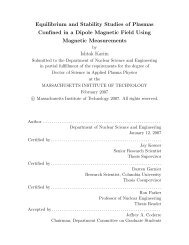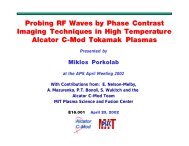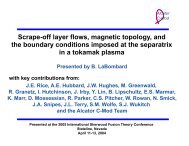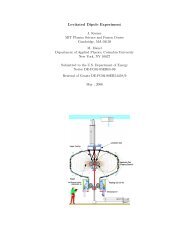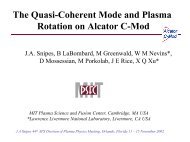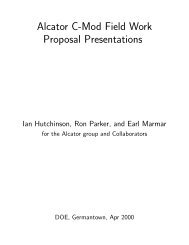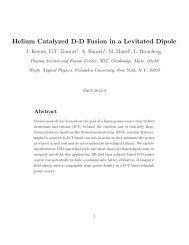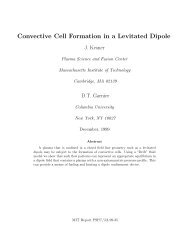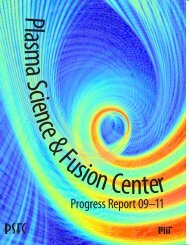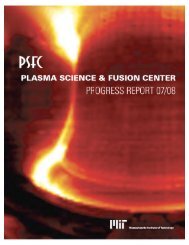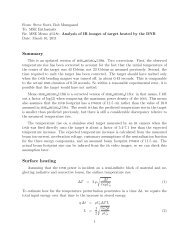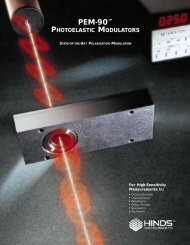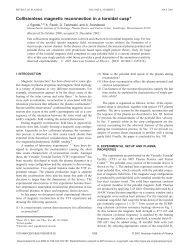Detailed analysis of MSE spectra
Detailed analysis of MSE spectra
Detailed analysis of MSE spectra
Create successful ePaper yourself
Turn your PDF publications into a flip-book with our unique Google optimized e-Paper software.
From: Steve Scott<br />
To: Howard Yuh, Bob Granetz<br />
Re: <strong>MSE</strong> Memo #8: <strong>Detailed</strong> Analysis <strong>of</strong> <strong>MSE</strong> FFT Spectra<br />
Date: July 2, 2003<br />
Motivation<br />
Previous memos in this series have carried out standard Müeller Matrix <strong>analysis</strong> for the mse<br />
diagnostic optics including the effect <strong>of</strong> imperfect mirrors which introduce a phase shift δ and<br />
a non-unity reflectivity ratio r m for the S- versus P- polarizations. The calculated photon<br />
intensity at the photomultiplier tubes is:<br />
[<br />
4I net = (I b + I 0 ) 1 + r m + r ]<br />
m − 1<br />
√ (cos(A) + sin(A) sin(B))<br />
2<br />
[<br />
+I 0 cos(2γ) r m − 1 + r ]<br />
m + 1<br />
√ (cos(A) + sin(A) sin(B))<br />
2<br />
+I 0 sin(2γ) √ 2r m [cos(δ) cos(B) + sin(δ)(sin(A) − sin(B) cos(A))] (1)<br />
where the time-dependent retardances imposed by the two pem’s are A(t) = R 1 cos(ω 1 t)<br />
and B(t) = R 2 cos(ω 2 t). Customarily, we operate both pem’s with a retardance amplitude<br />
R 1 = R 2 = π.<br />
I wrote a small idl procedure to calculate I net (t) directly from Eq. 1 given user-supplied<br />
values for the mirror properties, the pem retardances, the pitch-angle <strong>of</strong> the magnetic field in<br />
the coordinate frame <strong>of</strong> the mse diagnostic. Then I performed standard fft decomposition<br />
to determine the expected fft amplitudes for various assumptions about the diagnostic<br />
performance. This provides a check on analytic calculations <strong>of</strong> the fft amplitudes, which<br />
are obtained using the expansions:<br />
cos(R cos(ωt)) =<br />
∞∑<br />
J 0 (R) + (−1) n J 2n (R) cos(2nωt)<br />
n=1<br />
sin(R cos(ωt)) =<br />
∞∑<br />
2 (−1) n−1 J 2n−1 (R) cos((2n − 1)ωt). (2)<br />
n=1<br />
Note that the terms sin(A(t)) sin(B(t)) and sin(B(t)) cos(A(t)) in Eq. 1 will give rise to a<br />
large number <strong>of</strong> fft components at frequencies corresponding to sums and differences <strong>of</strong> ω 1<br />
and ω 2 .<br />
It’s convenient to group the terms into two sets: ‘ideal’ frequencies at which we expect<br />
nonzero fft amplitudes for mirrors having no phase shift (δ = 0), and additional ‘nonideal’<br />
terms that arise when the mirrors introduce a phase shift. These frequencies are listed in<br />
Table 1. Since ω 1 ≈ ω 2 , the ideal frequencies tend to be grouped around the even multiplies<br />
<strong>of</strong> the pem frequencies, while the nonideal frequencies tend to be groupe around the odd<br />
multiples. As we will see in subsequent plots, the expected fft spectrum is quite rich, with<br />
significant fft amplitudes out to at least 4 times the fundamental pem frequency, and with<br />
4-5 split components near each harmonic.<br />
1
Ideal Nonideal<br />
0 ω 1<br />
2ω 1 3ω 1<br />
4ω 1 5ω 1<br />
6ω 1 7ω 1<br />
8ω 1 9ω 1<br />
2ω 2 ω 2<br />
4ω 2 3ω 2<br />
6ω 2 5ω 2<br />
8ω 2 7ω 2<br />
ω 1 ± ω 2 9ω 2<br />
3ω 1 ± ω 2 2ω 1 ± ω 2<br />
5ω 1 ± ω 2 4ω 1 ± ω 2<br />
7ω 1 ± ω 2 6ω 1 ± ω 2<br />
3ω 2 ± ω 1 8ω 1 ± ω 2<br />
5ω 2 ± ω 1 3ω 2 ± 2ω 1<br />
7ω 2 ± ω 1 4ω 1 ± 3ω 2<br />
3ω 1 ± 3ω 2 5ω 2 ± 2ω 1<br />
5ω 1 ± 3ω 2 6ω 1 ± 3ω 2<br />
5ω 2 ± 3ω 1 5ω 2 ± 4ω 1<br />
5ω 1 ± 5ω 2 7ω 2 ± 2ω 1<br />
7ω 1 ± 3ω 2<br />
7ω 2 ± 3ω 1<br />
9ω 1 ± 1ω 2<br />
9ω 2 ± 1ω 1<br />
Table 1: Frequencies at which we expect nonzero fft amplitudes for ideal and nonideal<br />
mirrors. Nonideal mirrors will have the frequency components listed in both columns.<br />
Expected Signals When only One PEM is Operating<br />
If we turn <strong>of</strong>f pem#2, then<br />
I net = M p · M P EM1 · M m · S v . (3)<br />
Doing the matrix multiplication with Maple yields an intensity<br />
4I net = (I 0 + I b )(1 + r m + r m − 1<br />
√ cos(A) 2<br />
+I 0 cos(2γ)(r m − 1 + r m + 1<br />
√ cos(A)) 2<br />
+I 0 sin(2γ) √ 2r m (cos(δ) + sin(δ) sin(A)). (4)<br />
Making the usual substitutions yields the intensities:<br />
I ω1 = I 0 sin(δ) √ r m J 1 (A 1 )<br />
√<br />
2<br />
sin(2γ)<br />
2
Figure 1: Computed fft spectrum for mse operating with both pems at their customary<br />
retardance (R 1 = R 2 = π) for imperfect mirrors having a large phase shift, δ = 30 o . A<br />
field-line pitch angle <strong>of</strong> 24 o with respect to the pem optics is assumed. The light green<br />
lines represent frequencies that are expected from ideal mirrors. The yellow lines reprsent<br />
frequencies that are expected from the non-ideal mirror behavior. The important point <strong>of</strong><br />
this figure is that non-negligible fft amplitudes occur only at those frequencies where we<br />
expect them - all <strong>of</strong> the fft features correspond to either a known ideal or a known non-ideal<br />
frequency.<br />
3
Figure 2: Computed fft spectrum for mse operating with both pems at their customary<br />
retardance (R 1 = R 2 = π) for perfect mirrors having no shift, δ = 0 o and equal reflectivity<br />
for S- and P- polarization. A field-line pitch angle <strong>of</strong> 24 o with respect to the pem<br />
optics is assumed. Magenta vertical lines indicate the frequencies corresponding to simple<br />
harmonics <strong>of</strong> the pem frequencies. The blue lines represent the fft amplitudes that are<br />
close to frequencies expected for ideal mirrors listed in Table 1. In subsequent plots, green<br />
lines represent fft amplitudes that are near frequencies expected from the non-ideal mirror<br />
characteristics.<br />
4
Figure 3: fft spectrum for mse operating with both pems at their customary retardance<br />
(R 1 = R 2 = π) for perfect mirrors having no shift, δ = 0 o and equal reflectivity for S- and<br />
P- polarization. A field-line pitch angle <strong>of</strong> 24 o with respect to the pem optics is assumed.<br />
This is the same case as the previous plot, Fig. 2, but plotted on a log scale to allow the<br />
identification <strong>of</strong> low-amplitude components.<br />
5
Figure 4: fft spectrum for mse operating with both pems at their customary retardance<br />
(R 1 = R 2 = π) for imperfect perfect mirrors having a moderate phase shift, δ = 5 o and<br />
unity reflectivity for S- and P- polarization. A field-line pitch angle <strong>of</strong> 24 o with respect to<br />
the pem optics is assumed. Note that the mirror’s phase shift creates new but rather small<br />
fft amplitudes near the first and third harmonics <strong>of</strong> both pem frequencies.<br />
6
Figure 5: fft spectrum for mse operating with both pems at their customary retardance<br />
(R 1 = R 2 = π) for imperfect perfect mirrors having a moderate phase shift, δ = 5 o and<br />
unity reflectivity for S- and P- polarization. A field-line pitch angle <strong>of</strong> 24 o with respect to<br />
the pem optics is assumed. Note that the mirror’s phase shift creates new but rather small<br />
fft amplitudes near the first and third harmonics <strong>of</strong> both pem frequencies. This is the same<br />
case as the previous plot, Fig. 4, but plotted on a log scale to allow the identification <strong>of</strong><br />
low-amplitude components.<br />
7
Figure 6: fft spectrum for mse operating with both pems at their customary retardance<br />
(R 1 = R 2 = π) for imperfect perfect mirrors having a large phase shift, δ = 30 o and unity<br />
reflectivity for S- and P- polarization. A field-line pitch angle <strong>of</strong> 24 o with respect to the<br />
pem optics is assumed. Note that the mirror’s phase shift creates new but rather small fft<br />
amplitudes near the first and third harmonics <strong>of</strong> both pem frequencies.<br />
8
Figure 7: fft spectrum for mse operating with both pems at their customary retardance<br />
(R 1 = R 2 = π) for imperfect perfect mirrors having a large phase shift, δ = 30 o and unity<br />
reflectivity for S- and P- polarization. A field-line pitch angle <strong>of</strong> 24 o with respect to the<br />
pem optics is assumed. Note that the mirror’s phase shift creates new but rather small fft<br />
amplitudes near the first and third harmonics <strong>of</strong> both pem frequencies. This is the same<br />
case as the previous plot, Fig. 6, but plotted on a log scale to allow the identification <strong>of</strong><br />
low-amplitude components.<br />
9
Figure 8: fft spectrum for mse operating with both pems at their customary retardance<br />
(R 1 = R 2 = π) for imperfect perfect mirrors having a very large phase shift, δ = 60 o and<br />
unity reflectivity for S- and P- polarization. A field-line pitch angle <strong>of</strong> 24 o with respect to<br />
the pem optics is assumed. Note that the mirror’s phase shift creates new but rather small<br />
fft amplitudes near the first and third harmonics <strong>of</strong> both pem frequencies.<br />
10
Figure 9: fft spectrum for mse operating with both pems at their customary retardance<br />
(R 1 = R 2 = π) for imperfect perfect mirrors having a very large phase shift, δ = 60 o and<br />
unity reflectivity for S- and P- polarization. A field-line pitch angle <strong>of</strong> 24 o with respect to<br />
the pem optics is assumed. Note that the mirror’s phase shift creates new but rather small<br />
fft amplitudes near the first and third harmonics <strong>of</strong> both pem frequencies. This is the same<br />
case as the previous plot, Fig. 8, but plotted on a log scale to allow the identification <strong>of</strong><br />
low-amplitude components.<br />
11
Figure 10: Computed ratio <strong>of</strong> fft amplitude at 20 kHz to 40 kHz as a function <strong>of</strong> the<br />
assumed phase shift, δ, introduced by the mse mirrors. For these calculations both pems<br />
are assumed to be operating at their nominal retardance, R 1 = R 2 = π and the mirrors are<br />
assumed to have the same reflectivity for S- and P- polarizations.<br />
12
Figure 11: Computed ratio <strong>of</strong> fft amplitude at 20 kHz to 40 kHz as a function <strong>of</strong> the<br />
assumed phase shift, δ, introduced by the mse mirrors. For these calculations both pems<br />
are assumed to be operating at their nominal retardance, R 1 = R 2 = π and the mirrors are<br />
assumed to have the same reflectivity for S- and P- polarizations. This is the same data as<br />
shown in Fig. 10 but the x-axis has been expanded.<br />
13
Figure 12: fft spectrum for mse operating with both pems at their customary retardance<br />
(R 1 = R 2 = π) for imperfect perfect mirrors having a large phase shift, δ = 30 o and in<br />
addition a reflectivity ratio R m = 0.6 and a ratio <strong>of</strong> unpolarized-to-polarized light <strong>of</strong> 10:1.<br />
A field-line pitch angle <strong>of</strong> 24 o with respect to the pem optics is assumed. The point <strong>of</strong> this<br />
plot is whether we can possibly generate the fft amplitudes that we observe at the first<br />
harmonic by even unreasonable assumptions about non-ideal features <strong>of</strong> the mirrors.<br />
14
Figure 13: fft spectrum for mse operating with both pems at their customary retardance<br />
(R 1 = R 2 = π) for imperfect perfect mirrors having a large phase shift, δ = 30 o and in<br />
addition a reflectivity ratio R m = 0.6 and a ratio <strong>of</strong> unpolarized-to-polarized light <strong>of</strong> 10:1.<br />
A field-line pitch angle <strong>of</strong> 24 o with respect to the pem optics is assumed. The point <strong>of</strong> this<br />
plot is whether we can possibly generate the fft amplitudes that we observe at the first<br />
harmonic by even unreasonable assumptions about non-ideal features <strong>of</strong> the mirrors. This<br />
is the same plot as Fig. 12<br />
15
Figure 14: Bessel functions J 0 , J 1 , and J 2 . The nominal retardance <strong>of</strong> the pems is R = π.<br />
There is a zero <strong>of</strong> J 0 at 2.405 and a zero <strong>of</strong> J 1 at 3.832 so if the actual retardance <strong>of</strong> one or<br />
both pems deviates from the nominal value by about 0.7 we would see unusual ratios <strong>of</strong> the<br />
22 kHz to 20 kHz.<br />
16
δ (degrees) I 40 /I 20 I 22 /I 20<br />
5 26.8 0.72<br />
30 4.6 0.72<br />
60 2.6 0.72<br />
R <strong>MSE</strong> (cm)<br />
86.8 3.5 0.029<br />
85.3 4.4 0.023<br />
83.7 3.9 0.024<br />
82.1 4.4 0.036<br />
78.5 4.4 0.018<br />
76.6 5.0 0.059<br />
74.6 5.9 0.086<br />
72.5 7.5 0.15<br />
70.9 7.5 0.21<br />
67.1 2.7 0.16<br />
Table 2: Comparison <strong>of</strong> expected intensity ratios (for different assumptions about the phase<br />
shift imposed by the mirror) to the observed intensity ratio on calibration shot 1030521013.<br />
Note that the intensity ratio I 40 /I 20 is matched only if we assume a very large phase shift<br />
<strong>of</strong> order 30 o , whereas from the mirror specs we expect a phase shift <strong>of</strong> less than a degree<br />
or so. However, we observe very little intensity at 22 kHz, e.g. in the outer channels the<br />
observed intensity in the 20 kHz component is 25-50 times larger than the 22 kHz component,<br />
whereas we expect them to have roughly the same intensity if the pem retardances are at<br />
their nominal values, R 1 = R 2 = π. So imperfect mirrors that impose a large phase shift <strong>of</strong><br />
order 30 o would be consistent with our data only if the retardance is also <strong>of</strong>f.<br />
I ω2 = 0.<br />
I 2ω1 = (I b + I 0 )J 2 (A 1 )(1 − r m )<br />
2 √ − I 0J 2 (A 1 )(1 + r m )<br />
2<br />
2 √ cos(2γ)<br />
2<br />
I 2ω2 = 0. (5)<br />
Note that the intensities for ω 1 and 2ω 1 are just the same as when both pem#1 and pem#2<br />
are operating. Also note that there will be a nonzero intensity at frequency ω 1 only if the<br />
mirrors introduce a phase shift, i.e. if mirrors were perfect (δ = 0), there would be no<br />
intensity at ω 1 .<br />
Similarly, we we turn <strong>of</strong>f pem#1, then<br />
which yields<br />
I net = M p · M P EM2 · M m · S v . (6)<br />
4I net = (I 0 + I b )(1.707r m + 0.2929)<br />
+I 0 cos(2γ)(1.707r m − 0.2929)<br />
+I 0 sin(2γ)(cos(δ) cos(B) − sin(δ) sin(B)). (7)<br />
17
This yields intensities:<br />
I ω1 = 0.<br />
I ω2 = − I 0<br />
I 2ω1 = 0.<br />
I 2ω2 = − I 0<br />
√<br />
rm sin(δ)J 1 (A 2 )<br />
√<br />
2<br />
sin(2γ)<br />
√<br />
rm cos(δ)J 2 (A 2 )<br />
√<br />
2<br />
sin(2δ) (8)<br />
The fft amplitude <strong>of</strong> 2ω 2 is the same as for the case when both pems are operating. The<br />
fft amplitude <strong>of</strong> ω 2 has the same parametric dependence as when both pems are operating,<br />
except that it has been reduced in magnitude by a factor J 0 (A 1 ). The lack <strong>of</strong> symmetry is<br />
troubling.<br />
18
Figure 15: fft spectrum for mse operating with only pem-1 at its customary retardance<br />
(R 1 = π) for perfect mirrors having no phase shift, δ = 0 o . A field-line pitch angle <strong>of</strong> 24 o<br />
with respect to the pem optics is assumed. As expected, we lose the fft components that<br />
involve 2ω 2 .<br />
19
Figure 17: fft spectrum for mse operating with only pem-1 at a nonstandard retardance<br />
(R 1 = 1.1π) for perfect mirrors having no phase shift, δ = 0 o . A field-line pitch angle <strong>of</strong> 24 o<br />
with respect to the pem optics is assumed.<br />
21
Figure 18: fft spectrum for mse operating with only pem-1 at a nonstandard retardance<br />
(R 1 = 1.3π) for perfect mirrors having no phase shift, δ = 0 o . A field-line pitch angle <strong>of</strong> 24 o<br />
with respect to the pem optics is assumed.<br />
22
Figure 19: fft spectrum for mse operating with only pem-1 at a nonstandard retardance<br />
(R 1 = 2π) for perfect mirrors having no phase shift, δ = 0 o . A field-line pitch angle <strong>of</strong> 24 o<br />
with respect to the pem optics is assumed.<br />
23
Figure 20: fft spectrum for mse operating with only pem-2 at a standard retardance<br />
(R 2 = π) for an imperfect mirror having a large phase shift, δ = 30 o . A field-line pitch angle<br />
<strong>of</strong> 24 o with respect to the pem optics is assumed.<br />
24
Figure 21: fft spectrum for mse operating with both pems with the second pem operating<br />
at a standard retardance (R 2 = π) but the first pem operating at a retardance that sits at<br />
the zero <strong>of</strong> the zero-th order Bessel function, R 1 = 2.405 for an imperfect mirror having a<br />
large phase shift, δ = 30 o . A field-line pitch angle <strong>of</strong> 24 o with respect to the pem optics<br />
is assumed. As predicted by the <strong>MSE</strong> Memo #7, the choice <strong>of</strong> this retardance for pem#1<br />
removes the fft amplitude at ω 2 .<br />
25
Memo #7 computed the effect <strong>of</strong> imperfect <strong>MSE</strong> mirrors, i.e. mirrors having a different<br />
reflectance for S- and P- polarizations and/or mirrors which introduce a phase shift, on the<br />
<strong>MSE</strong> analyis. We concluded that one signature <strong>of</strong> imperfect mirrors would be to generate<br />
fft components at the pem fundamental frequencies in addition to the usual components<br />
at the second harmonic <strong>of</strong> the pem frequencies:<br />
I ω1 = J 1(A 1 )I<br />
√ 0<br />
Z sin(2γ) (9)<br />
2<br />
(10)<br />
I ω2 = − J 1(A 2 )J 0 (A 1 )I<br />
√ 0<br />
Z sin(2γ) (11)<br />
2<br />
I 2ω1 = − J 2(A 1 )I<br />
√ 0<br />
(S cos(2γ) + T (1 + I b /I 0 )) (12)<br />
2<br />
I 2ω2 = − J 2(A 2 )I<br />
√ 0<br />
Y sin(2γ). (13)<br />
2<br />
where Z is a parameter that arises from the phase shift (i.e. Z = 0 if there is no phase shift)<br />
and T is a parameter that arises from the non-ideal reflectance (i.e. T = 0 if the reflectance<br />
is the same for both S- and P- polarizations). One ‘signature’ <strong>of</strong> non-ideal mirrors would<br />
then be a particular ratio <strong>of</strong> the fft amplitudes at the first harmonic pem frequencies:<br />
I ω2<br />
= − J 0(A 1 )J 1 (A 2 )<br />
I ω1 J 1 (A 1 )<br />
(14)<br />
We believe that both pems are configured to impose a retardance <strong>of</strong> π/2, so A 1 = A 2 = π/2.<br />
Then J 0 (π/2) = 0.472 and J 1 (A 2 ) = 0.567 and J 1 (A 1 ) = 0.567 so the ratio becomes<br />
I ω2<br />
I ω1<br />
= −0.47. (15)<br />
The problem is that, empirically, we observe this ratio to be essentially zero.<br />
One possible explanation for this observation would be if the actual retardance for PEM#1<br />
were to be close to zero <strong>of</strong> J 0 , which occurs for A 1 = 2.405.<br />
This memo works through the arithmetic for a simpler problem, namely a single mirror<br />
which has unity reflectance for the S- polarization, a reflectance r m for the P-polarization,<br />
and which introduces a phase shift δ. The advantage <strong>of</strong> this <strong>analysis</strong> is that we can compare<br />
it to published <strong>analysis</strong> by Nick Hawkes, who solved the same problem, which provides a<br />
check on the answer.<br />
Following Hawkes(JET-R(96)10), we analyze <strong>MSE</strong> optical elements using Müeller matrices<br />
to represent the effects <strong>of</strong> the mirrors, the PEMs, and the fixed polarizer. The Stokes<br />
vector for the output light, I net , is obtained by multiplying together the Müeller matrices for<br />
each element in their order along the optical path,<br />
I net = M p · M P EM2 · M P EM1 · M m · S v (16)<br />
26
Figure 22: Calculated time dependence <strong>of</strong> intensity <strong>of</strong> light passing through the mse diagnostic<br />
optics including pems assuming that only pem-1 is operating. A pitch-angle <strong>of</strong> 24 o<br />
is assumed, and perfect optics are assumed (δ = 0, R m = 1.0). The time dependence is<br />
illustrated for various assumptions <strong>of</strong> the maximum retardation imposed by pem-1 from 0<br />
to π radians. The nominal retardation value is π.<br />
27
Figure 23: Calculated time dependence <strong>of</strong> intensity <strong>of</strong> light passing through the mse diagnostic<br />
optics including pems assuming that only pem-1 is operating. A pitch-angle <strong>of</strong> 24 o<br />
is assumed, and perfect optics are assumed (δ = 0, R m = 1.0). The time dependence is<br />
illustrated for various assumptions <strong>of</strong> the maximum retardation imposed by pem-1 from π<br />
to 2π radians. The nominal retardation value is π.<br />
28
Figure 24: Calculated time dependence <strong>of</strong> intensity <strong>of</strong> light passing through the mse diagnostic<br />
optics including pems assuming that only pem-2 is operating. A pitch-angle <strong>of</strong> 24 o<br />
is assumed, and perfect optics are assumed (δ = 0, R m = 1.0). The time dependence is<br />
illustrated for various assumptions <strong>of</strong> the maximum retardation imposed by pem-1 from 0<br />
to π radians. The nominal retardation value is π.<br />
29
Figure 25: Calculated time dependence <strong>of</strong> intensity <strong>of</strong> light passing through the mse diagnostic<br />
optics including pems assuming that only pem-2 is operating. A pitch-angle <strong>of</strong> 24 o<br />
is assumed, and perfect optics are assumed (δ = 0, R m = 1.0). The time dependence is<br />
illustrated for various assumptions <strong>of</strong> the maximum retardation imposed by pem-1 from π<br />
to 2π radians. The nominal retardation value is π.<br />
30
Figure 26: Calculated ratio <strong>of</strong> fft amplitude at 4ω 1 to the amplitude at 2ω 1 as a function<br />
<strong>of</strong> retardance <strong>of</strong> the pem-1 for a situation where the mse diagnostic is operated with only<br />
pem-1 active. The calculated ratio is independent <strong>of</strong> the phase shift imposed by the mirrors,<br />
δ, and also independent <strong>of</strong> the pitch-angle <strong>of</strong> the field line.<br />
31
Figure 27: Computed ratio <strong>of</strong> signal intensity variation over time, (I max − I min )/(I max +<br />
I min ), as a function <strong>of</strong> pem-1 retardance when the mse diagnostic is operated with only<br />
pem-1 operational. The dependence for various field-line pitch-angles is illustated. These<br />
calculations assume that the mirrors impose zero phase shift, δ = 0, and that the ratio <strong>of</strong> S-<br />
to P- reflectivity is unity.<br />
32
Figure 28: Computed ratio <strong>of</strong> signal intensity variation over time, (I max − I min )/(I max +<br />
I min ), as a function <strong>of</strong> pem-2 retardance when the mse diagnostic is operated with only<br />
pem-2 operational. The dependence for various field-line pitch-angles is illustated. These<br />
calculations assume that the mirrors impose zero phase shift, δ = 0, and that the ratio <strong>of</strong> S-<br />
to P- reflectivity is unity.<br />
33
Figure 29: Computed ratio <strong>of</strong> signal intensity variation over time, (I max −I min )/(I max +I min ),<br />
as a function <strong>of</strong> pem-1 retardance when the mse diagnostic is operated with only pem-1<br />
operational. The dependence for various phase shifts imposed by the mirror (δ) is illustrated<br />
for a field-line pitch-angle <strong>of</strong> 24 o . . These calculations assume that the ratio <strong>of</strong> S- to P-<br />
reflectivity is unity.<br />
34
Figure 30: Computed ratio <strong>of</strong> signal intensity variation over time, (I max −I min )/(I max +I min ),<br />
as a function <strong>of</strong> pem-s retardance when the mse diagnostic is operated with only pem-2<br />
operational. The dependence for various phase shifts imposed by the mirror (δ) is illustrated<br />
for a field-line pitch-angle <strong>of</strong> 24 o . . These calculations assume that the ratio <strong>of</strong> S- to P-<br />
reflectivity is unity.<br />
35
Figure 31: Calculated ratio <strong>of</strong> fft amplitude at 4ω 1 to the amplitude at 2ω 1 as a function<br />
<strong>of</strong> retardance <strong>of</strong> the pem-1 or pem-2 for a situation where the mse diagnostic is operated<br />
with only one pem active. The calculated ratio is independent <strong>of</strong> the phase shift imposed<br />
by the mirrors, δ, and also independent <strong>of</strong> the pitch-angle <strong>of</strong> the field line.<br />
36
Figure 32: Calculated ratio <strong>of</strong> fft amplitude at 4ω 1 to the amplitude at 2ω 1 as a function<br />
<strong>of</strong> retardance <strong>of</strong> the pem-1 or pem-2 for a situation where the mse diagnostic is operated<br />
with only one pem active. The calculated ratio is independent <strong>of</strong> the phase shift imposed by<br />
the mirrors, δ, and also independent <strong>of</strong> the pitch-angle <strong>of</strong> the field line. This is an expanded<br />
version <strong>of</strong> Fig. 31.<br />
37
Figure 33: Calculated ratio <strong>of</strong> fft intensity ratio at 4ω to 2ω when both pem’s are operational.<br />
Calculations were performed for both δ = 0 and δ = 15 o (no difference).<br />
38
where M m is the Müeller matrix for a mirror, M P EM1 and M P EM2 are the Müeller matrices for<br />
the first and second photoelastic modulators, M p is the Müeller matrix for a static polarizer<br />
at 22.5 o , and S v is the Stokes vector for the partially polarized light incident on the mse<br />
diagnostic:<br />
⎡<br />
⎤<br />
I b + I 0<br />
I<br />
S v = 0 cos(2γ)<br />
⎢<br />
⎥<br />
(17)<br />
⎣ I 0 sin(2γ) ⎦<br />
0<br />
where I 0 is the intensity <strong>of</strong> the polarized light (polarized at an angle γ to the horizontal) and<br />
I b is the intensity <strong>of</strong> the background, unpolarized light. The Müeller matrix for the mirror<br />
is<br />
⎡ r m+1 r m−1<br />
⎤<br />
0 0<br />
2 2 r m−1 r m+1<br />
0 0<br />
M m = ⎢ 2 2 √ √ ⎥<br />
(18)<br />
⎣ 0 0 rm cos(δ) rm sin(δ)<br />
0 0 − √ ⎦<br />
√<br />
r m sin(δ) rm cos(δ)<br />
The Müeller matrices for the PEMs at 0 o and 45 o are:<br />
⎡<br />
M P EM1 = ⎢<br />
⎣<br />
⎡<br />
M P EM2 = ⎢<br />
⎣<br />
1 0 0 0<br />
0 cos(A) 0 − sin(A)<br />
0 0 1 0<br />
0 sin(A) 0 cos(A)<br />
1 0 0 0<br />
0 1 0 0<br />
0 0 cos(B) sin(B)<br />
0 0 − sin(B) cos(B)<br />
⎤<br />
⎥<br />
⎦<br />
⎤<br />
⎥<br />
⎦<br />
(19)<br />
(20)<br />
and the PEM for a fixed polarizer at 22.5 o is<br />
⎡<br />
M p = 1 ⎢<br />
4 ⎣<br />
√ √<br />
√<br />
2 2 2 0<br />
√ 2 1 1 0<br />
2 1 1 0<br />
0 0 0 0<br />
⎤<br />
⎥<br />
⎦<br />
(21)<br />
Relationship <strong>of</strong> Measured Intensities to Polarization Angle<br />
I used Maple to carry out the matrix multiplication. The output intensity, taken from<br />
the first component <strong>of</strong> the output Stokes vector, is<br />
[<br />
4I net = (I b + I 0 ) 1 + r m + r ]<br />
m − 1<br />
√ (cos(A) + sin(A) sin(B))<br />
2<br />
[<br />
+I 0 cos(2γ) r m − 1 + r ]<br />
m + 1<br />
√ (cos(A) + sin(A) sin(B))<br />
2<br />
+I 0 sin(2γ) √ 2r m [cos(δ) cos(B) + sin(δ)(sin(A) − sin(B) cos(A))] (22)<br />
39
Now we make use <strong>of</strong> the expansions<br />
cos(A) = cos(A 1 cos(ω 1 t)) = J 0 (A 1 ) − 2J 2 (A 1 ) cos(2ω 1 t)<br />
cos(B) = cos(A 2 cos(ω 2 t)) = J 0 (A 2 ) − 2J 2 (A 2 ) cos(2ω 2 t))<br />
sin(A) = sin(A 1 cos(ω 1 t)) = 2J 1 (A 1 ) cos(ω 1 t)<br />
sin(B) = sin(A 2 cos(ω 2 t)) = 2J 1 (A 2 ) cos(ω 2 t)) (23)<br />
We can now evaluate the intensities at the frequencies: ω 1 , 2ω 1 , ω 2 , and 2ω 2 :<br />
I ω1 = I 0 sin(δ) √ r m J 1 (A 1 )<br />
√ sin(2γ)<br />
2<br />
I ω2 = − I 0 sin(δ) √ r m J 0 (A 1 )J 1 (A 2 )<br />
√<br />
2<br />
I 2ω1 = (I b + I 0 )J 2 (A 1 )(1 − r m )<br />
2 √ 2<br />
sin(2γ)<br />
− I 0J 2 (A 1 )(1 + r m )<br />
2 √ 2<br />
cos(2γ)<br />
I 2ω2 = − I 0J 2 (A 2 ) √ r m cos(δ)<br />
√<br />
2<br />
sin(2γ). (24)<br />
The expressions for I ω1 , I 2ω1 , and I 2ω2 agree with those <strong>of</strong> Hawkes (Hawkes didn’t publish<br />
the result for I ω2 .) So we come to the same conclusion as before, namely<br />
I ω2<br />
= − J 0(A 1 )J 1 (A 2 )<br />
I ω1 J 1 (A 1 )<br />
(25)<br />
Conclusions<br />
40



